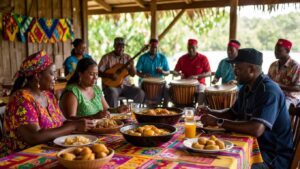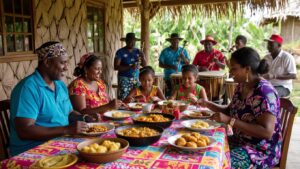Explore the Colorful Garifuna Culture in Belize: A Deep Dive into Heritage, Culinary Delights, and Cultural Engagement
The Garifuna community in Belize represents a vibrant cultural mosaic, intricately woven from African, Indigenous Caribbean, and European influences, resulting in a unique heritage that has garnered international recognition, including from UNESCO. Their cultural expressions encompass a rich array of elements such as language, music, cuisine, dance, spiritual beliefs, and a strong sense of community. This extensive guide invites you to embark on a captivating journey through the Garifuna legacy in Belize, delving into their historical origins, cultural practices, festivals, culinary experiences, and the thriving cultural atmosphere found in Hopkins Village.
Uncover the Rich Heritage and Traditions of the Garifuna People
The Garifuna stand out as one of the most prominent cultural groups in Belize, with their ancestry tracing back to ancestors from West and Central Africa, alongside the Indigenous Carib and Arawak peoples. Their historical narrative took a significant turn in 1797 when they were exiled to Central America after resisting colonial oppression in St. Vincent. Presently, the Garifuna population in Belize is approximately 30,000, who enrich the southern Belizean cultural landscape with their unique language, delectable cuisine, vibrant artistic expressions, and cherished traditions. Recognised by UNESCO as a Masterpiece of the Oral and Intangible Heritage of Humanity, the Garifuna spirit thrives in communities such as Dangriga, Hopkins, Seine Bight, and Punta Gorda, along with diaspora populations across the Americas. The annual celebration of Garifuna Settlement Day on November 19th serves as a powerful reminder of their resilience and rich cultural heritage.

Delve into the Historical Evolution of the Garifuna Community
Tracing the Ancestry of the Garifuna: A Fusion of African and Carib Heritage
The origins of the Garifuna people date back to the 17th century, marked by the extraordinary convergence of African survivors from two Spanish slave ships with the Indigenous Carib and Arawak communities of St. Vincent in the Lesser Antilles. Over a span of more than 150 years, a rich tapestry of intermarriage and cultural exchange led to the emergence of a distinct Afro-Indigenous identity known as the Garinagu. This identity is characterised by a vibrant blend of traditions, languages, and cultural practices that reflect their diverse ancestral heritage, showcasing the resilience and adaptability of the Garifuna in overcoming numerous historical obstacles.
Forced Displacement and the Formation of New Communities in Belize
In 1797, after their courageous resistance against British colonial powers, approximately 5,000 Garifuna were forcibly relocated from St. Vincent to Roatán, Honduras. This marked the onset of migrations that ultimately facilitated the establishment of thriving Garifuna communities along the Central American coastline. By the early 19th century, significant Garifuna settlements emerged in southern Belize, particularly in culturally vibrant regions like Dangriga, often referred to as the cultural capital, along with Hopkins, Seine Bight, and Barranco. British authorities recognized these migrations as essential for creating a skilled labor force adept in fishing and agriculture, leading to the prosperity of these communities.
Cultural Resilience in the Face of Adversity: The Pursuit of Continuity
Despite the numerous challenges posed by European colonization, land dispossession, and systemic discrimination, the Garifuna have successfully preserved their language, social structures, and rich spiritual traditions. The establishment of the National Garifuna Council in 1981 has played a crucial role in advocating for cultural rights and educational initiatives, ensuring that the vibrant heritage of the Garifuna community is celebrated and maintained for future generations.
Language and Identity: Fundamental Pillars of Garifuna Culture
The Unique Characteristics of the Garifuna Language
The Garifuna language is a remarkable Arawakan language enriched with Carib and African loanwords, making it a unique linguistic example among Central American languages. This language features gender-specific pronouns, a sophisticated tense system, and a wealth of oral traditions that encapsulate the community’s historical narratives and cultural values. However, the survival of the Garifuna language faces substantial threats due to a language shift caused by migration and urbanization, with fewer than 15,000 individuals in Belize remaining proficient in this vital aspect of their cultural identity.
Revitalization Initiatives: Safeguarding the Garifuna Language and Traditions
The recognition of the Garifuna language and musical traditions as an Intangible Heritage by UNESCO in 2001 has ignited revitalization efforts. In communities such as Hopkins and Dangriga, primary schools have begun to incorporate educational programs in Garifuna, and local radio stations are broadcasting music and news in the language, helping to preserve its vibrancy. Furthermore, organizations like GAMAE International have organized language immersion summer camps aimed at reconnecting the youth with their ancestral roots and linguistic heritage, fostering a renewed appreciation for their cultural identity.
Strengthening Identity Through Traditions and Global Connections
The Garifuna identity is reinforced through traditional attire, ancestral lineage, clan symbols, and distinctive naming customs. This identity is actively nurtured by cultural associations both within Belize and in diaspora communities located in major cities such as New York, Los Angeles, and London, where they continuously celebrate and promote their rich heritage.
The Energetic World of Garifuna Music and Dance
Dynamic Drumming and Its Spiritual Importance in Garifuna Culture
Garifuna music is celebrated for its complex rhythmic structures that harmoniously merge traditional African polyrhythms with Indigenous chants. Drums, particularly the primero (tenor) and segunda (bass), play a central role in various spiritual rituals and celebrations. The sacred dugú ceremony, for example, incorporates drum circles and ancestral invocations designed to heal or bless families, reflecting the profound connection between music and spirituality within Garifuna culture. These musical expressions transcend mere entertainment; they are crucial conduits for cultural transmission and communal identity.
Vibrant Dance Styles: Punta and Punta Rock
Among the most cherished Garifuna dance forms is the punta, characterised by swift hip movements and intricate footwork, often accompanied by call-and-response singing and lively percussion. The modern adaptation of this dance style, known as punta rock, has gained popularity through renowned musicians such as Andy Palacio and Pen Cayetano, who blend traditional rhythms with contemporary instrumentation, effectively expanding the reach of Garifuna culture to international audiences while fostering cross-cultural appreciation.
Festivals: Uniting the Community Through Dance and Music
In the vibrant towns of Hopkins and Dangriga, local dance troupes frequently perform during cultural festivals and for visiting tourists, creating a vital connection between generations. These performances not only celebrate Garifuna heritage but also serve as significant economic resources for the community, promoting tourism and enabling cultural exchange. The lively atmosphere and shared experiences during these events forge enduring connections among participants, both local and international.

Exploring the Spiritual Practices and Cultural Beliefs of the Garifuna
The Significance of the Dugú Ceremony in Garifuna Life
The dugú ceremony is a profoundly important multi-day event where extended families converge to honor the spirits of their ancestors, known as gubida. Guided by a spiritual healer, or buyei, the ceremony encompasses music, dance, and communal feasting, all aimed at restoring harmony within families and the community at large. This ritual underscores a deep respect for the land, ancestral legacies, and collective responsibilities inherent in Garifuna culture.
Everyday Spirituality and Cultural Practices of the Garifuna Community
The spiritual beliefs of the Garifuna represent a unique blend of Catholicism and African and Arawak cosmologies. Daily life is enriched by various rituals, including blessings for new buildings, rites of passage for births and deaths, and agricultural celebrations. Important symbols such as the conch shell, sea turtle, and cassava create vital connections between households and the natural world, as well as the ancestral spirits, weaving a spiritual framework that guides everyday interactions and community practices.
Diving into the Culinary Treasures of Garifuna Cuisine
Core Ingredients and Signature Dishes of Garifuna Gastronomy
The culinary heritage of Garifuna culture is firmly rooted in staples such as cassava (or yuca), plantains, coconut, and fresh seafood. Among traditional offerings, ereba stands out as a delicious cassava bread crafted from grated cassava, pressed, and toasted over an open flame. Another signature dish, hudut, features fish simmered in creamy coconut milk served alongside mashed green and ripe plantains. Other beloved dishes include machuca, a hearty fish soup with garlicky, mashed plantain dumplings, and tapou, a savory seafood stew prepared with coconut milk. In the bustling markets of Hopkins and Dangriga, visitors can indulge in local delicacies such as cassava pone (a sweet cake), fried plantain balls (known as ganún), and refreshing conch ceviche, each offering a tantalizing taste of the rich Garifuna culinary legacy.
Advancing Sustainable Food Practices Within the Garifuna Community
Traditional Garifuna practices, including seasonal fishing, shellfish gathering, and small-scale gardening, promote ecological stewardship and sustainable livelihoods. These practices are guided by cultural taboos and principles of communal resource management, fostering a deep connection to the land and its resources. Culinary festivals held in Hopkins celebrate cooking contests and food tours organised by women’s cooperatives, ensuring the preservation of cherished recipes and culinary techniques while actively involving visitors in the rich gastronomic heritage of the Garifuna.
Hopkins Village: The Cultural Epicenter of Garifuna Heritage
The Historical Importance and Cultural Significance of Hopkins
Established in the early 1800s and known as Yarumein in Garifuna, Hopkins is located along the picturesque Stann Creek coast, serving as a crucial hub for the Garifuna language, music, and crafts. It encapsulates the rich cultural legacy of the community. As a focal point for cultural preservation, Hopkins plays an essential role in maintaining the Garifuna identity amidst an ever-evolving global landscape.
Must-Experience Activities in Hopkins Village
- Drum Circles: Participate in daily drum schools and enjoy the lively atmosphere of nightly drum circles at local cultural centers.
- Garifuna Museum: Explore artefacts, oral histories, and photographic archives that illuminate the community’s migration, language, and music.
- Homestays and Workshops: Connect with local families offering cooking lessons, fishing expeditions, and demonstrations on cassava bread making, enriching your understanding of Garifuna culinary traditions.
Annual cultural events in Hopkins, especially the youth pageants held during Garifuna Settlement Day, establish the village as an authentic gateway to experiencing the rich cultural tapestry of Garifuna Belize, inviting visitors to immerse themselves in the vibrant traditions of the Garifuna community.
The Economic Significance of Cultural Tourism in Hopkins
Cultural tourism acts as a vital economic driver in Hopkins, supporting over 75% of local households through guest accommodations, handicrafts, music lessons, and guided tours. The headquarters of the National Garifuna Council coordinates regional festivals and advocacy efforts, ensuring that Garifuna culture remains dynamic and visible to the world while also empowering the local community through sustainable economic practices.
Commemorating Garifuna Settlement Day: A Celebration of Cultural Legacy
The Historical Significance of Settlement Day
Since 1941, and nationally recognised since 1977, Garifuna Settlement Day commemorates the monumental arrival of Garifuna ancestors in Belize by canoe in 1802. The reenactment procession known as Yurumein sees villagers arriving ashore carrying drums, cassava, and crops amidst joyful singing and prayer, symbolising their enduring legacy and cultural resilience.
Contemporary Celebrations: Merging Tradition with Festivity
The celebrations of Garifuna Settlement Day artfully blend sacred and secular elements, featuring nightlong dugú ceremonies and all-day drumming in churches and community squares. Parades adorned in traditional attire, lively processions, dance performances, and food fairs characterize this vibrant day. National broadcasts, media features, and diaspora celebrations in major cities in the US attract visitors from across Belize and beyond, enhancing awareness and appreciation for Garifuna cultural traditions and fostering a sense of global community.
Navigating Modern Challenges and Sustaining Cultural Heritage
The Language Shift Challenge Among Younger Generations
The language shift phenomenon poses a significant threat to the Garifuna community, as many young individuals, particularly in urban settings, increasingly communicate in English or Kriol at home. Recognising this concerning trend, UNESCO has encouraged schools and NGOs to implement language immersion programmes, radio broadcasts, and mentorship initiatives aimed at preserving linguistic heritage and cultural identity, ensuring that the rich linguistic diversity of the Garifuna is safeguarded for future generations.
Land Rights Issues and the Effects of Tourism Development
The rapid growth of tourism and real estate development in coastal areas such as Seine Bight and Hopkins presents risks to the traditional landholdings of the Garifuna people. Advocacy efforts from the National Garifuna Council and collaborative NGOs focus on securing land rights, influencing urban planning, and ensuring that tourism revenue benefits local families and communities, fostering sustainable development that respects the cultural and historical significance of Garifuna lands.
Empowering Youth Through Arts, Technology, and Diaspora Engagement
Garifuna artists and musicians, both locally and in the diaspora, are actively involved in recording music, documenting recipes, and preserving oral histories to create digital archives and virtual festivals. These modern platforms are instrumental in fostering connections between the broader Garifuna community and younger generations, ensuring that their rich cultural heritage is not only maintained but also celebrated and transmitted to future generations.
Guidelines for Experiencing Garifuna Culture Responsibly and Respectfully
- Select accommodations in Hopkins, Dangriga, or Seine Bight, and book tours directly with Garifuna-owned businesses to support the local economy and promote sustainable tourism practices.
- Engage in a drum workshop, attend a Settlement Day celebration, or volunteer in local cultural preservation initiatives to fully immerse yourself in the vibrant culture.
- Support women’s cooperatives by sampling traditional dishes or purchasing handcrafted items, thereby promoting sustainable livelihoods and economic empowerment.
- Always respect local customs; seek permission before taking photographs of individuals, and remain considerate during rituals and ceremonies to honour the cultural significance of these practices.
- Learn a few basic phrases in the Garifuna language to demonstrate your respect and genuine interest in the culture, fostering a deeper connection with the community.
The Garifuna culture in Belize is a vibrant tapestry of resilience, profound spirituality, infectious music, exquisite culinary offerings, and strong community ties. By visiting places like Hopkins or Dangriga, participating in local festivals, or immersing oneself in the rhythmic heartbeat of the drums, travelers are granted a unique opportunity to connect with a rich historical continuum where the past and present resonate harmoniously. Supporting Garifuna-owned businesses, honoring their traditions, and celebrating the linguistic and culinary diversity of this remarkable culture are essential steps to ensure its survival and flourishing for generations to come.
Comprehensive References for Further Exploration of Garifuna Culture
- Language, Dance and Music of the Garifuna – UNESCO Intangible Heritage
- History Of The Garifuna People – Belize.com
- Garifuna people – Wikipedia
- Varner, G.R. “Native Status and Maya Identity in Belize.” Journal of Latin American Anthropology, 1998
- Lee, N.R. “Toledo Garifuna and Indigenous Rights.” Mesoamerican Research, 2022
- National Garifuna Council – Wikipedia
- The Garifuna Living Heritage – ICH NGO Forum, 2023
- Dinther, R. “Language Shift and Prestige: Garifuna in Hopkins.” Journal of Pidgin and Creole Languages, 2017
- Habinaha Garifuna Language Program
- Veal, T. “Africanisms in Garifuna Culture of Belize.” Cultural Anthropology, 2004
- National Geographic: Preserving Garifuna Identity Through Ritual
- Music In Africa: Punta Rock and Garifuna Music
- Hopkins Cultural Center Official Site
- Cultural Survival Quarterly: Maya Rainforest and Garifuna in Belize
- Belize Living Heritage: Rituals and Social Practices
- Texas A&M: Belizean Food Culture
- Love Your Belize: Hudut Recipe
- Global M&A Pages: Sustainable Fishing Cooperatives
- National Garifuna Council of Belize
- UN Sustainable Development Reports on Garifuna Cultural Tourism
- Ambergris Caye: Garifuna Settlement Day Celebrations
- Garifuna.com: Diaspora, Digital Storytelling, and Modern Initiatives
The Article Garifuna Culture in Belize: Heritage, Food & Where to Experience It appeared first on Belize Travel Guide
The Article Garifuna Culture: Experience Heritage and Cuisine in Belize Was Found On https://limitsofstrategy.com
The Article Garifuna Culture: Discover Belize’s Heritage and Cuisine First Appeared ON
: https://ad4sc.com


